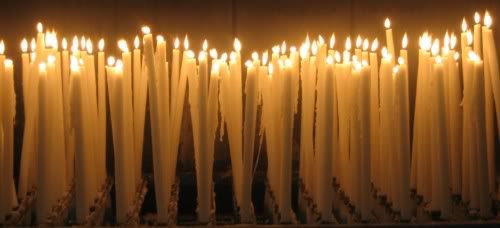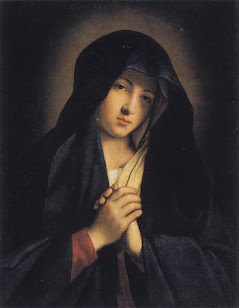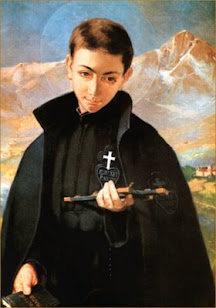So, it is the 115th day of the year, and I haven’t really written about the history of the Holy Rosary itself. Church tradition holds that Our Blessed Mother appeared to Saint Dominic de Guzman in the thirteenth century, presenting him with the Rosary that we pray today. However, the Rosary—in some form—long predates the thirteenth century, and the meditations on the Holy Mysteries of the Rosary, came long after the visitation of the Blessed Mother. Therefore, while the core of this holy prayer was provided by The Blessed Virgin to Saint Dominic, the Church has, over time, provided guidance in the meditation and contemplation of the lives of Mary and Jesus over time (for example, the addition of the Mysteries of Light by Pope John Paul II).
In medieval times, the first roots of the Holy Rosary can be found—the practice of monks and friars singing the Divine Office on a daily basis, a practice which took upwards of eight hours! The Divine Office was complicated, changing daily depending on liturgical year, seasons, etc., and therefore was far too difficult for most laypersons to undertake given the lack of educational achievement at that time. The Divine Office was also far too time consuming for priests and brothers who didn’t reside in monasteries to complete on a daily basis. To simplify, and yet provide a manner in which these laity and religious could pray on a daily basis, a briefer version was put together called the breviary. Still too complicated for the laity, a number of solutions were suggested, including reciting the 150 Psalms each day.
Now, the 150 Psalms took some time to recite, and subsequently the meditation was divided by three, with fifty Psalms remaining each day. To make matters more difficult, many Christians at the time could not read, and therefore would have to commit the Psalms to memory, which was no easy task. Therefore, prayers (such as the Our Father and Hail Mary) were substituted for the psalter, in effect, yielding a chain of fifty prayers each day. As it was easy to lose track of one’s place, a prayer device was required—a string of prayer beads, the precursor to the modern Rosary.
So, in the beginning, we can see that the practice of praying the Rosary was not so much a devotion, as it was a prayer aid. This changed in the thirteenth century with the visitation of the Blessed Virgin to Saint Dominic. Saint Dominic, the founder of the Dominican Order (feast day, August 8), traveled throughout the country, converting those he encountered. However, he found great resistance to his preaching, and turned to Our Blessed Mother for help in a forest in Toulouse. He prayed, fasted, and engaged in severe physical mortification for three days and three nights, eventually falling into a trance-like coma. As Holy Legend tells us, it is at this point that Our Blessed Mother appeared to Dominic, saying, “Dear Dominic, do you know which weapon the Blessed Trinity wants to use to reform the world?" Dominic answered, "Oh, my Lady, you know far better than I do, because next to your Son Jesus Christ you have always been the chief instrument of our salvation."
Our Blessed Mother continued to speak with Saint Dominic, encouraging him to pray the Marian Psalter (the practice of praying 150 Hail Marys), as with that prayer aid, he would reach sinners and convert them. "My son," Mary said, "prayer and penance are the only way to win souls. Pray my Psalter and teach it to your people. That prayer, will never fail." She concluded by saying, “One day, through the Rosary and the Scapular, I will save the world.” Per Legend, Saint Dominic ran to the Cathedral and preached to an assembled crowd, a great storm raging, and devotion to the Holy Rosary of Our Blessed Mother began.
Pope Pius XI (1922-1939) stated: "The Rosary of Mary is the principle and foundation on which the very Order of Saint Dominic rests for making perfect the life of its members and obtaining the salvation of others." Pope Benedict XIV ( 1740-58 ), a renowned scholar and a promoter of historical studies and research, spoke about the tradition of Saint Dominic and the Rosary by saying: "You ask whether St. Dominic was the first institutor of the Rosary, and show that you yourselves are bewildered and entangled in doubts on the matter. Now, what value do you attach to the testimony of so many Popes, such as Leo X (1521), Pius V (1572), Gregory XIII (1585), Sixtus V (1590), Clement VIII (1605), Alexander VII (1667), Bl. Innocent XI (1689), Clement XI (1721), Innocent XIII (1724) and others who unanimously attribute the institution of the Rosary to St. Dominic, the founder of the Dominican Order, an apostolic man who might be compared to the apostles themselves and who, undoubtedly due to the inspiration of the Holy Spirit, became the designer, the author, promoter, and most illustrious preacher of this admirable and truly heavenly instrument, the Rosary?”
Devotion grew, spread by Saint Dominic and the Dominican Order, and the Rosary of Our Lady became a common practice. In the fifteenth century, another Dominic-- Dominic of Prussia-- a Carthusian monk in Poland, introduced the idea of meditating on fifty events in the life of Jesus while reciting the 50 Hail Marys. Eventually, these meditations became the Glorious, Joyful, and Sorrowful Mysteries. The addition of the Luminous Mysteries by Pope John Paul II brought the total to 20 events in the birth, life, ministry, death, and resurrection of Jesus—which we still contemplate today while praying the Rosary. The Creed, Doxology, Fatima Prayer, and others have been added over time, creating a rhythmic, but highly personal and contemplative, prayer exercise which with to meditate on the life of our Savior, Jesus Christ, and the role His mother, Our Blessed Virgin, played for Him, and continues to play for us, interceding on our behalf.
In future posts, I will address the physical aspects of the Rosary itself, including the criticisms that using beads “externalizes” prayer, or that the Rosary is, by it’s very nature, the type of “vain repetition” of prayer that the Bible warns against. In a careful analysis of the devotion, we see more clearly that the beads form a chaplet which directs us inward, towards our Lord who resides inside of us, with each bead leading us to our next prayer, contemplatively drawing us deeper toward the Mysteries of our faith.
Given the origins of the Holy Rosary in the psalter, for the next 150 days, I will contemplate the Psalms, one per day, as I pray the Holy Rosary for the intentions of those readers who have submitted requests on this blog. I encourage you all to join me in this exercise!
1 Blessed is the man
who does not walk in the counsel of the wicked
or stand in the way of sinners
or sit in the seat of mockers.
2 But his delight is in the law of the LORD,
and on his law he meditates day and night. (Psalm 1: 1-2)
Day 115 of 365
Prayer Intentions: For those who weep, for those who pray, for those who fear.
Requested Intentions: For the repose of the soul of M (J); Financial security and employment (A); For financial security (M); Health and recovery of Cardinal Sean Brady (R); Healing from a chronic illness (J); Deepening of faith and true conversion for a family (J); Successful employment (H); Restoration of a marriage (J); For a friend’s daughter, seeking medical treatment for a blood disorder (D); For the grace and conversion of a loved one (Z); For a beloved son’s return to the faith (A); For the improved health and recovery of a mother (G); For health, blessings, and protection (K); For an improvement in a difficult employment situation (T).
Psalm: Psalm 1: True Happiness
Why pray the Rosary every day for a year?
Each time the Blessed Virgin has appeared-- whether it be to Saint Bernadette Soubirous at Lourdes; to Lucia, Jacinta, and Francisco at Fatima; or to Mariette Beco at Banneux-- she has asserted the importance, saving grace, and power of praying the Holy Rosary on a daily basis. Based upon her words, the Rosary is penance and conversion for sinners, a pathway to peace, an end to war, and a powerful act of faith in Jesus Christ. Pope Paul VI presented the Rosary as a powerful means to reach Christ "not merely with Mary but indeed, insofar as this is possible to us, in the same way as Mary, who is certainly the one who thought about Him more than anyone else has ever done."
To show us how this is done, perhaps no one has been more eloquent than the great Cardinal Newman, who wrote: "The great power of the Rosary consists in the fact that it translates the Creed into Prayer. Of course, the Creed is already in a certain sense a prayer and a great act of homage towards God, but the Rosary brings us to meditate again on the great truth of His life and death, and brings this truth close to our hearts. Even Christians, although they know God, usually fear rather than love Him. The strength of the Rosary lies in the particular manner in which it considers these mysteries, since all our thinking about Christ is intertwined with the thought of His Mother, in the relations between Mother and Son; the Holy Family is presented to us, the home in which God lived His infinite love."
As Mary said at Fatima, "Jesus wants to use you to make Me known and loved. He wishes to establish the devotion to My Immaculate Heart throughout the world. I promise salvation to whoever embraces it; these souls will be dear to God, like flowers put by Me to adorn his throne."

Subscribe to:
Post Comments (Atom)















Thank you for this entry! I will be sharing this with our Mother's Group and our Lay Apostles who pray the rosary together once a month.